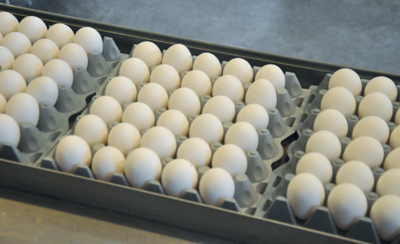
Tempering Egg Size
By Treena Hein
Features Business & Policy TradeUniversity of Guelph research reveals complexity of trying to moderate egg size as layers age
Egg producers are keen for an effective way to counter the natural
tendency for older hens to produce extra large eggs, especially with
attention being given to extending the current lay cycle. There’s no
economic incentive to produce these very large grade of eggs and they
also tend to have a higher incidence of cracks.
Egg producers are keen for an effective way to counter the natural tendency for older hens to produce extra large eggs, especially with attention being given to extending the current lay cycle. There’s no economic incentive to produce these very large grade of eggs and they also tend to have a higher incidence of cracks.
 |
Although it’s well known that egg size is affected by both body weight of the layer and her diet – particularly the intake of protein and the amino acid methionine – little research has been conducted in this area using modern strains of layers.
 |
|
| Dr. Steve Leeson’s research demonstrates the influence of diet quality on the delicate balance between egg number and egg size
|
Dr. Steve Leeson is changing that. “Feeding older layers less protein/methionine should help temper the natural egg size increase,” says Leeson, a professor in the Department of Animal and Poultry Science at University of Guelph. “Reducing crude protein level in the diet also has the added environmental benefit of decreasing the nitrogen loading of manure.”
Just how far crude protein can be reduced is a ticklish subject, however. While producers would be overjoyed to control egg size by cutting protein or certain amino acids, there are concerns that these diet changes may lower egg production at the same time.
In order to provide solid recommendations to industry, Leeson and his research team have been studying the response of layers to varying levels of protein/amino acid reduction through a complete laying cycle. In their experiment, a group of 18 week-old Shaver White Pullets were divided equally and housed in individual cages in two identically maintained rooms, held at 25 C, with a photoperiod of 14 hours light/10 hours dark.
The birds were then fed a complex series of diets at intervals over a one-year period. “The focus of these diets was sequential decreases in protein, the amino acid methionine and also the combination of methionine with cysteine,” says Leeson. Each diet was fed to 16 replicate groups of four birds through a conventional laying cycle.
The research team monitored hen performance characteristics, such as egg production, on a daily basis throughout the trial. Eggs were collected during the last two days of each month for measurement of egg weight. Eggshell deformation, which is a non-destructive test of shell quality, was measured at the end of periods three, six and nine. Albumen height was measured at the end of period six. Feed intake was measured at the end of all periods, and body weight was measured at the start, end and during period six.
Leeson found “if dietary protein level was reduced too quickly, there was loss in egg number, which is obviously not good for producers.” The research team also observed the highest peak egg number in birds that consumed the most methionine. “Based on these results, we therefore wouldn’t recommend that producers try and save money by reducing diet levels of protein too early, and especially too quickly,” Leeson says.
Regarding the diets given later in the laying cycle, the research team found that subsequent reductions in protein and amino acids had only a small effect on reducing egg size. “That is,” says Leeson, “as the percentage of protein and amino acids were reduced in the diet, the hens just ate more, which counteracted any effects of the diet change.”
Despite not demonstrating that egg size can be reduced by reducing protein in the diet of chickens, Leeson says the results of this study do confirm the influence of diet quality on the delicate balance between egg number and egg size.
And, even though it’s clear that maintaining high dietary protein levels ensures egg numbers are maximized, there are negative aspects of this practice, namely increased water intake and increased ammonia production.
Leeson found that water consumption by chickens eating 20.5 per cent crude protein versus 15.5 per cent crude protein (with the same level of component amino acids) is 10-15 per cent higher. The birds are drinking more water in order to flush the unwanted nitrogen through their kidneys. Since birds on high protein diets drink more water, their manure is wetter, which contributes to more ammonia in the barn. “This may be a future issue that gains more attention as legislators look at the impact of ammonia, from all sources, on the environment.,” he said.
Overall, Leeson says, “It looks as though we are feeding excessive amounts of crude protein to layers and this is negatively impacting feed intake, water intake and ammonia production.” He believes producers can feed less crude protein without jeopardizing the levels of critical amino acids such as methionine.
“If we start off with less crude protein,” he says, “then there is less need for subsequent major reductions in protein, a situation that may result in loss in egg numbers from our high peaking strains today.”
Print this page